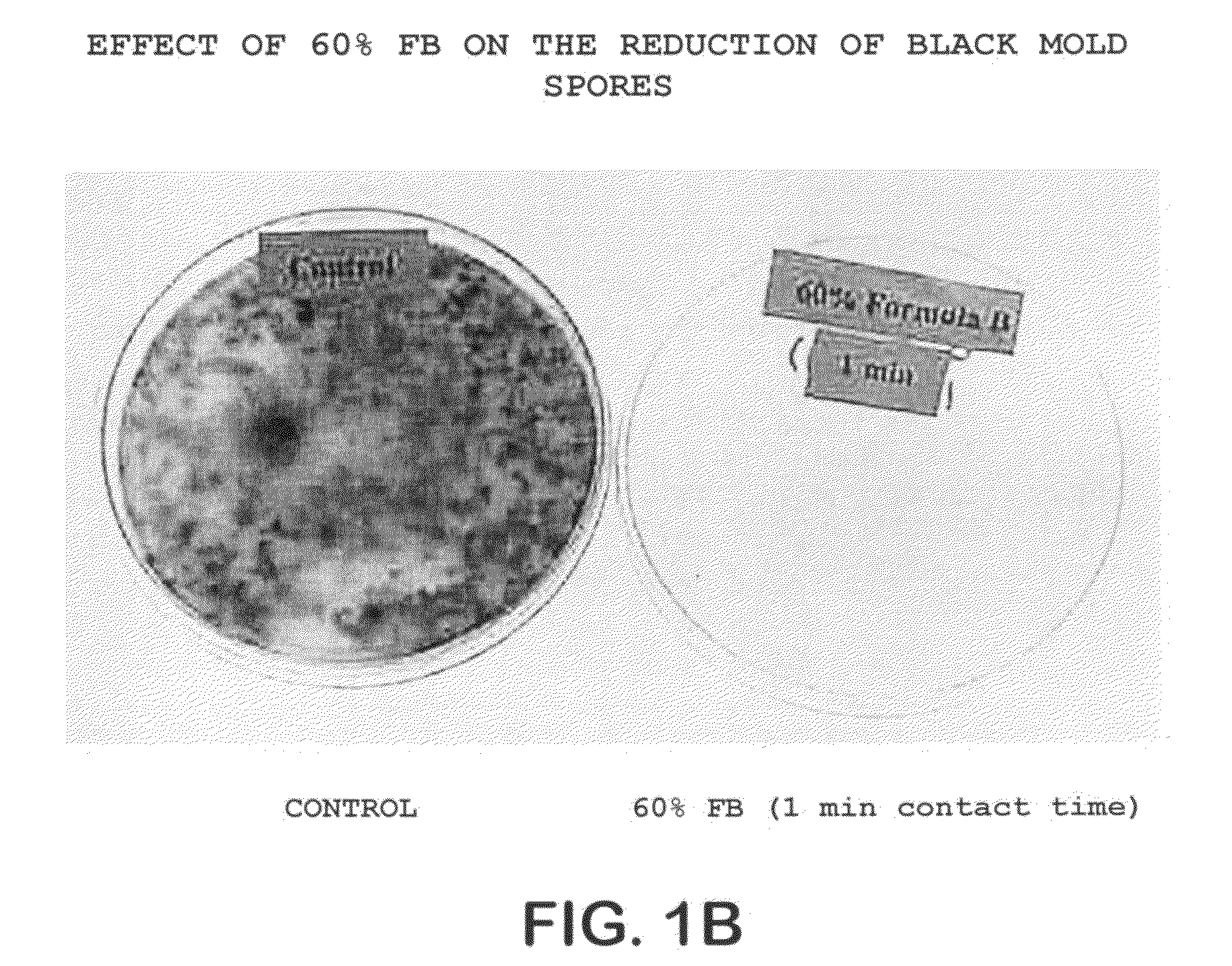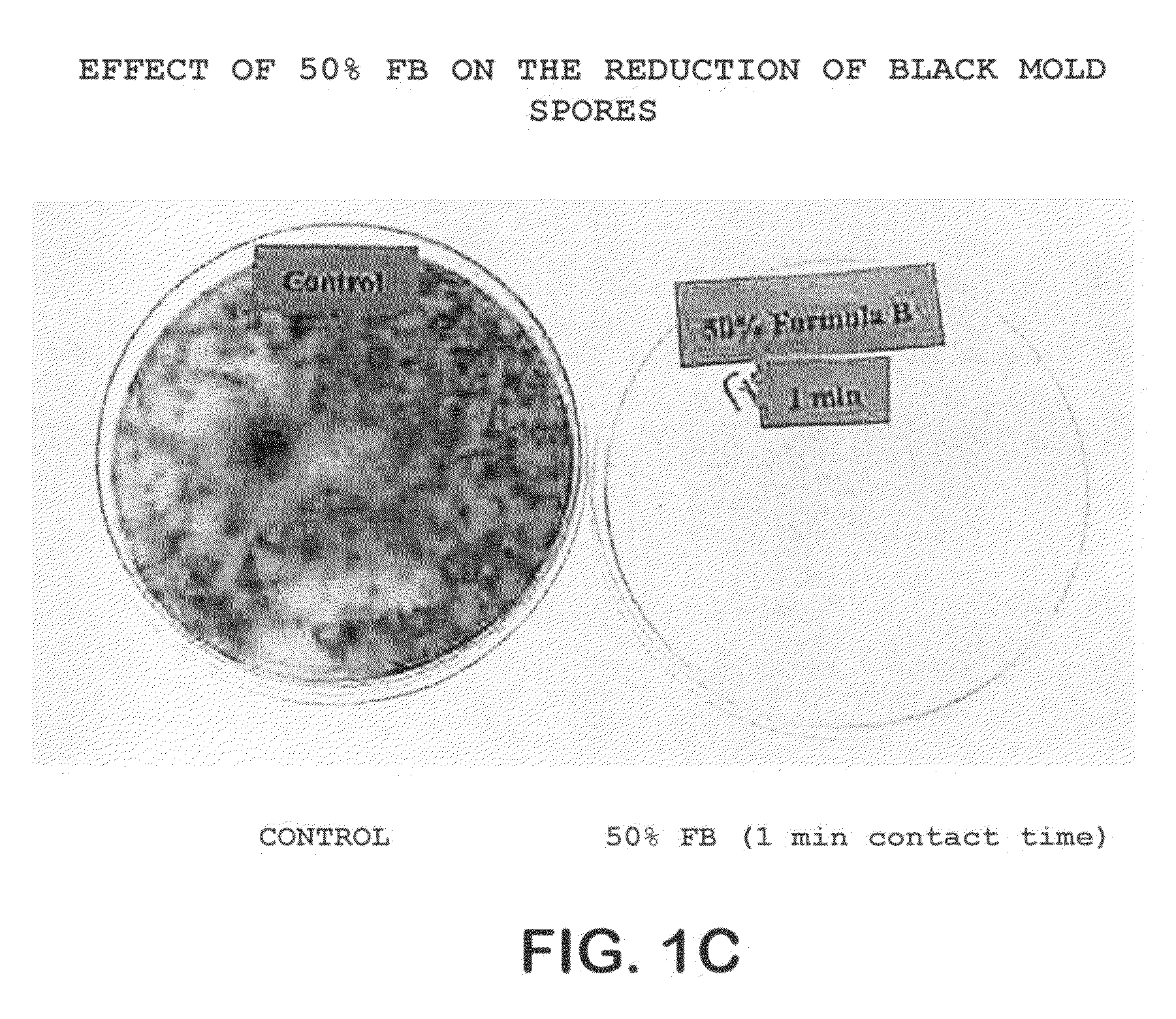Methods and composition for treating a material
a technology of composition and material, applied in the direction of disinfectants, biocide, disinfection, etc., can solve the problems of not being able to sterilize medical and surgical materials with alcohol, affecting the sanitization effect of materials, and irritating hands of personnel, so as to improve the activity of germicidal and sporicidal spectra and activities of lower alkanols (c1-c6), prevent cutaneous penetration and further contamination, and improve the effect o
- Summary
- Abstract
- Description
- Claims
- Application Information
AI Technical Summary
Benefits of technology
Problems solved by technology
Method used
Image
Examples
example 1
[0088]
TABLE 1ComponentComposition (FB)AmountAlkanol (ml):Ethanol62Fatty acid (g):Lauric acid10Alkalinating agent(g):Potassium hydroxide3.5Water (ml):Deionized26pH:14.42The mixture was made up to a volume of 100 ml with deionized water.
[0089]The following summary of results and data is based on tests performed on black mold spores using the composition (FB) of Table 1. Stachybotrys chartarum, commonly known as the “black house-mold”, has become a major problem in homes and office buildings, costing the building and insurance industries billions of dollars each year. The fungus grows best on cellulose containing materials such as mill paper, fiber board, wood and gypsum board, in moist warm environments such as homes previously subjected to water damage from condensation, leakage and flooding. There are nearly 120 million housing units and 5 million commercial buildings in the U.S. that are potentially susceptible to this water damage. Individuals who have come in contact with Stachyb...
example 2
[0097]The antimicrobial effect on Stachybotrys chartarum spores using compositions with pre-made fatty acid soaps and fatty acid soaps generated in situ by neutralizing the free fatty acids with an excessive amount of alkalinating agent was investigated.
TABLE 6Component (I)Composition (I)Amount (I)Alkanol (ml):Ethanol62Free fatty acid (mole):Lauric acid0.05Alkalinating agent (mole):Potassium hydroxide0.06Water (ml):Deionized26pH:14.42The mixture was made up to a volume of 100 ml with deionized water.
[0098]The killing of Stachybotrys chartarum spores by the composition of Table 6 was complete.
TABLE 7Component (II)Composition (II)Amount (II)Alkanol (ml):Ethanol62Fatty acid soaps (mole):Potassium laurate0.05Alkalinating agent (mole):Potassium hydroxide0.01Water (ml):Deionized26pH:14.42The mixture was made up to a volume of 100 ml with deionized water.
[0099]The killing of Stachybotrys chartarum spores by the composition of Table 7 was complete.
[0100]Thus, there was no difference in the ...
example 3
[0101]Bacterial spores are highly resistant to chemical and physical agents. They are recognized as the most difficult microorganisms to kill. The most important spore forming bacteria are members of the genera Bacillus and Clostridium. Bacillus anthracis and Clostridium difficile have nearly a worldwide distribution. Large outbreaks of Clostridium difficile have been described in hospitals. The spores of this pathogen are able to survive for long periods in hospital environments, e.g., on floors and around toilets. Bacillus spores, which are abundant in the soil, cause infection in farm and wild animals, and human who are in contact with infected animals or ingested contaminated meat. Bacillus anthracis spores have been recognized as a very dangerous biological warfare agent. It is extremely important to find an efficient control measure to neutralize these infectious agents. The sterilizing effect of the compositions of this invention was examined on Bacillus atropheus spores adhe...
PUM
| Property | Measurement | Unit |
|---|---|---|
| pH | aaaaa | aaaaa |
| temperature | aaaaa | aaaaa |
| volume | aaaaa | aaaaa |
Abstract
Description
Claims
Application Information
 Login to View More
Login to View More - R&D
- Intellectual Property
- Life Sciences
- Materials
- Tech Scout
- Unparalleled Data Quality
- Higher Quality Content
- 60% Fewer Hallucinations
Browse by: Latest US Patents, China's latest patents, Technical Efficacy Thesaurus, Application Domain, Technology Topic, Popular Technical Reports.
© 2025 PatSnap. All rights reserved.Legal|Privacy policy|Modern Slavery Act Transparency Statement|Sitemap|About US| Contact US: help@patsnap.com



